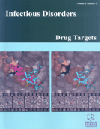-
oa Editorial [Hot topic: Infectious Diseases and Hematology: At the Crossroad of Contemporary Therapy (Guest Editors: Hau C. Kwaan and Michael G. Ison)]
- Source: Infectious Disorders - Drug Targets (Formerly Current Drug Targets - Infectious Disorders), Volume 11, Issue 1, Feb 2011, p. 1 - 2
-
- 01 Feb 2011
- Previous Article
- Table of Contents
- Next Article
Abstract
The fields of infectious diseases and hematology frequently intersect. Many hematologic disorders, particularly the hematologic malignancies, predispose the patient to a wide range of infectious complications. Conversely, infections have an effect on the hematologic picture, either directly, such as anemia of chronic infection, or leukocytosis associated with most bacterial infections, or indirectly, such as sepsis complicated by coagulopathy leading to disseminated intravascular coagulation (DIC). In this issue, we have chosen a series of articles written by authors with respective expertise in the study and clinical practice of either infectious diseases or hematology. These articles address the complexity of the pathogenesis and the clinical picture when the body is affected by both infection and hematologic disorders. We hope they will provide valuable information for the practitioner of both of these two disciplines. To begin with, Young, in her article entitled “Epidemiology and management of infectious complications of contemporary management of chronic leukemias,” provides a unique overview of the current management strategies for the control of chronic leukemias (chronic lymphocytic leukemia, chronic myelogenous leukemia, and hairy cell leukemia). She carefully reviews the mechanism of action and associated infections with the current treatment modalities, with monoclonal antibodies taking an increasing role. She then reviews the current literature correlating infectious risk with each of these treatments and provides evidence-based recommendations on prophylaxis strategies to minimize the impact of these complications. Next, Tessier and Sifri, in their article entitled “Epidemiology and Prevention of Bacterial Infections in Patients with Hematologic Malignancies,” provide a review focused on the pathogenesis for the increased risk of bacterial infections complications, along with epidemiology of bacterial infections in patients with hematologic malignancies and evidence-based recommendations on prevention and management of these complications. Hematopoietic stem cell transplantation is now an integral part of the management of malignant hematologic disorders. Infection is all too common a major cause of the morbidity and mortality of this procedure. Magauran and Salgado, in their article entitled “Challenges and Advances in Infection Control of Stem Cell Transplant Recipients,” review the current data to support infection control practices at stem cell transplant centers. The authors review the epidemiology of nosocomial infections in this unique population and provide evidence-based recommendations on how to mitigate these infections. In contrast to bacterial infection, virus presents another challenge in hematologic malignancies. Angarone, in his article entitled “Epidemiology and prevention of viral infections in patients with hematologic malignancies,” reviews the epidemiology and evidence-based prophylactic strategies to minimize viral complications of individuals with hematologic malignancies. Ison, in his article entitled “Epidemiology, prevention, and management of influenza in patients with hematologic malignancy,” provides a review of salient studies related to influenza infection in this unique population. Available data on the impact and management of the pandemic influenza A/H1N1 is also reviewed as are current guidelines for the prevention and management of seasonal and pandemic influenza infection. From the hematologic standpoint, anemia is often an important component of the clinical spectrum in infections. Kwaan detailed review in his article entitled “Infection and anemia the pathogenesis of changes in hematologic parameters directly or indirectly resulting from infections”. Specifically he reviews the conditions associated with anemia in patients with infections (anemia of chronic disease, hemolysis, red cell aplasia), hemolysis secondary to infection (parasitic destruction of erythrocytes, toxin-induced hemolysis, hemolytic-uremic syndrome, and hemolysis complicating antimicrobial therapy), and anemia resulting from blood loss (DIC, viral hemorrhagic fevers, and parasitic invasion of vascular walls).


